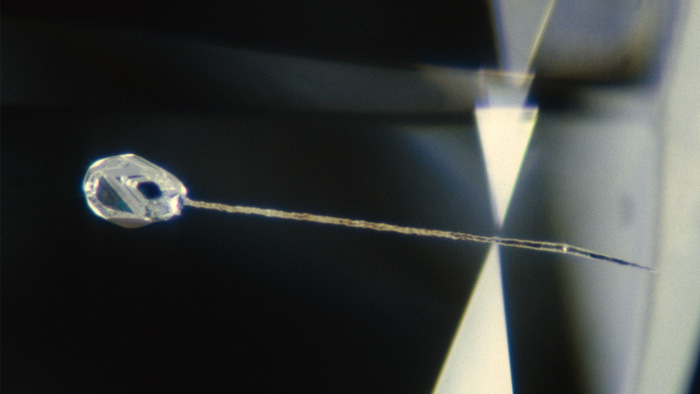What are clarity enhanced diamonds?
Clarity enhanced diamonds are natural diamonds which undergo a treatment process to artificially improve clarity in the diamond.
The treatment process typically falls into two main processes. Firstly laser drilling and secondly fracture filling. Both treatments aim to reduce the appearance of natural clarity characteristics within a diamond.
Laser drilled diamonds
Laser treatments involve drilling a fine laser hole through a diamond. This process burns away an internal inclusion. The laser hole allows access to bleach deep inclusions. As a result, the diamond benefits from enhanced clarity and an improved appearance. The image below, courtesy of the Gemological Institute of America shows the drill-hole under high magnification.
Laser holes can be very difficult to see, even with a trained eye. Under 10x magnification, we look for small holes on the surface of a diamond. From these holes, fine hair-like lines extend into the diamond as shown here.

Fracture filled diamonds
Fracture filling improves the appearance of a diamond’s clarity. In this treatment process, a glass-like resin is injected into the diamond. The resin fills visible feathers. Just like laser drilling, this treatment can be very hard to identify, even to the trained eye. Some diamonds treated this way exhibit a flash of purple or green owing to the differing optical properties of the resin.

Fracture filled diamond (before – left) and after treatment (right) photo courtesy of Gems and Gemology.
Should you buy a clarity enhanced diamond?
Buyers should avoid buying a clarity enhanced diamond for very good reasons. Firstly, few sellers disclose the exact treatment applied to any given diamond. Instead, a vague note appears to describe that the diamond is clarity enhanced.
Many buyers see their cheap price as advantageous, but diamond treatments massively de-value diamonds. But, most diamonds hold a higher value untreated with the original inclusions present.
One of the dangers associated with fracture-filled diamonds relates to temperature fluctuations. Proximity to heat during jewellery-making can cause a fracture-filled diamond to shatter. Some cleaners may remove or loosen the glass filling. As a result, the inclusion re-appears as if by magic!
For some buyers, this has often lead to the belief that their original diamond was swapped by the jeweller! This can happen years later. For example, when re-making a ring or when the ring undergoes routine cleaning.
Who could blame them for their surprise when a visible inclusion appears within their diamond?
Owing to the dangers of working with a fracture-filled diamond, most jewellers will not set a diamond treated in this way. For this reason, we routinely check any diamonds sent to us for setting into a finished ring mount.
Alternatives to clarity enhanced diamonds
Instead of buying a clarity enhanced diamond, we recommend buying a natural untreated diamond.
Safer, lower-cost alternatives include lab-grown diamonds or Moissanite. Both pose a lower risk than a clarity enhanced diamond. If you specifically want a natural diamond, consider lowering your sights in terms of the carat weight, colour, clarity or all three.
Please contact us for a personal quote for a natural or lab-grown diamond. Or, contact us for pricing on the option of adding a Moissanite to one of our jewellery designs.
About Mark Johnson
My name is Mark and I'm founder at Serendipity Diamonds. By day you'll find me working in our showroom—in a variety of roles. My work (which I love) ranges from photographing jewellery, to writing blog posts and helping clients with my colleagues Drina, Emily and Debbie.



